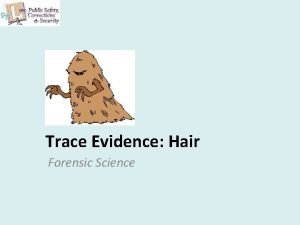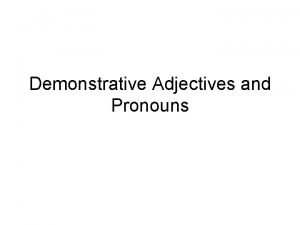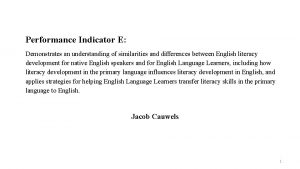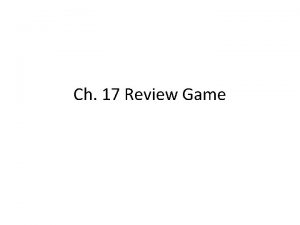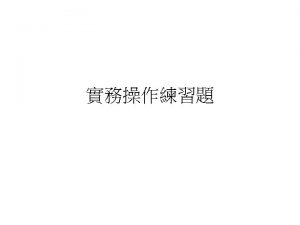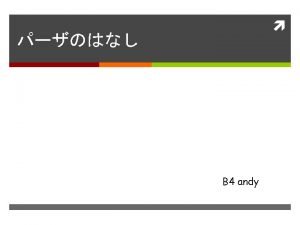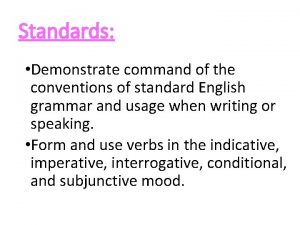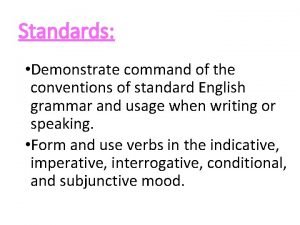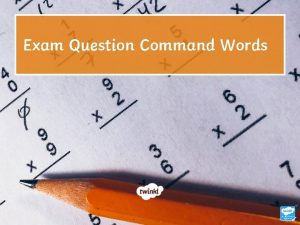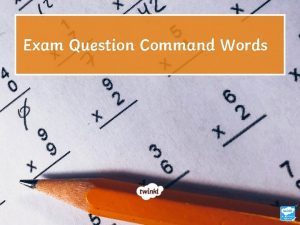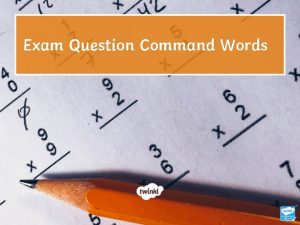Standards L 9 10 1 Demonstrate command of












- Slides: 12

Standards: L. 9 -10. 1 Demonstrate command of the conventions of standard English grammar and usage when writing or speaking. L. 9 -10. 2 Demonstrate command of the conventions of standard English capitalization, punctuation, and spelling when writing.

Quotation Marks Quotation marks enclose sentences or parts of a sentence that play a special role. For example, quotation marks can indicate that the words between them were first written or spoken by someone else or that they are being used in an unconventional way. Objectives: 1. Use quotations marks with direct quotations 2. Use quotations with title of short works 3. Use quotations for words or phrases used ironically or unconventionally 4. Use quotations in combination with other punctuation marks

Direct Quotations Double quotation marks set off direct quotations, including those in dialogue. Sing quotation marks enclose a quotation within a quotation. These are the following uses concerning direct quotations: 1. Double quotation marks enclose direct quotations 2. Quotation marks are not used for indirect quotations or paraphrases 3. Single quotation marks enclose quotations within quotations 4. Dialogue is enclosed in quotation marks 5. Thoughts are enclosed in quotation marks 6. Short excerpts of poetry included within a sentence are enclosed in quotation marks

Direct Quotations: (1) Double quotation marks enclose direct quotations Examples: “I believe that we learn by practice, ” writes Martha Graham. “Whether it means to learn to dance by practicing dancing or to learn to live by practicing live, the principles are the same. ” When using direct quotes, reproduce all quoted material exactly as it appears in the original, including capitalization and punctuation. Quick quiz! Is there a way to add extra information to a direct quote? Is there a way to take out extra information from a direct quote?

Direct Quotations: (2) Quotation marks are not used for indirect quotations or paraphrases Indirect quotations and paraphrases are restatements of what someone else has said or written. Example: “Martha Graham believes that practice is necessary for learning, regardless of what we are trying to learn.

Direct Quotations: (3) Single quotation marks enclose quotations within quotations If the quotation you are using includes another direct quotation, use single quotation marks for the embedded quotation. Example: According to Anita Erickson, “When the narrator says, ‘I have the right to my own opinion, ’ he means that he has the right to his own delusion. ” Quick quiz! Does the above rule apply to block quotes?

Direct Quotations: (4) Dialogue is enclosed in quotation marks Make sure your dialogue is always closed by adding quotation marks. Example: “Well, ” I retorted, “it depends on how you look at it. ”

Direct Quotations: (5) Thoughts are enclosed in quotation marks Quotation marks set off thoughts that resemble speech. Example: “His silence on this topic has surprised everyone, ” I noted to myself as I surveyed the face of the other committee members. This does not apply to indirect thoughts! Example: I wondered why he didn’t respond.

Direct Quotations: (6) Short excerpts of poetry included within a sentence are enclosed in quotation marks When quoting fewer than four lines of poetry, enclose them in quotation marks and use a slash to indicate the line division. Example: After watching a whale swim playfully, the speaker in “Visitation” asks, “What did you think, that joy/ was some slight thing? ”

Titles of short works Quotation marks enclose the title of a short work, such as a story, an essay, a poem, or a song. The title of larger works are italicized such as a book, magazine, newspaper, or play. Example: “The Green Shepherd” first appeared in The New Yorker. Quick Quiz! How do you quote a title in a longer title?

Using quotation marks for ironic tone or unusual usage Example: His “gourmet” dinner turned out to be processed turkey and instant mashed potatoes.

Practice Quotation marks signal that the words between the marks are the actual words said by the speaker. They also signal a title of a poem, story, song, and other works. Write a sentence as instructed below. Use quotation marks correctly. 1. Write a sentence where someone speaks. 2. Write a sentence using a song title. 3. Write a sentence where someone asks a question. 4. Write a sentence where someone says something, and there’s an exclamation point. 5. Write a sentence where someone says a quotation from someone else.
 Factors necessary for service standards are
Factors necessary for service standards are Human hair roots demonstrate a wineglass morphology
Human hair roots demonstrate a wineglass morphology Demonstrate two
Demonstrate two Mt carmel contest
Mt carmel contest Demonstrate adjective
Demonstrate adjective Demonstrate knowledge and understanding
Demonstrate knowledge and understanding Demonstrate
Demonstrate Demonstrate good subject and curriculum knowledge
Demonstrate good subject and curriculum knowledge Edip learning
Edip learning Bright synony,
Bright synony, Touching spirit bear chapter 12 summary
Touching spirit bear chapter 12 summary Summary vs analysis
Summary vs analysis Miller and urey's experiments attempted to demonstrate
Miller and urey's experiments attempted to demonstrate

